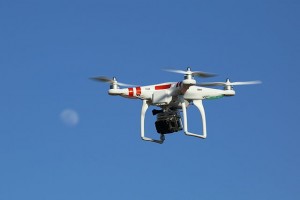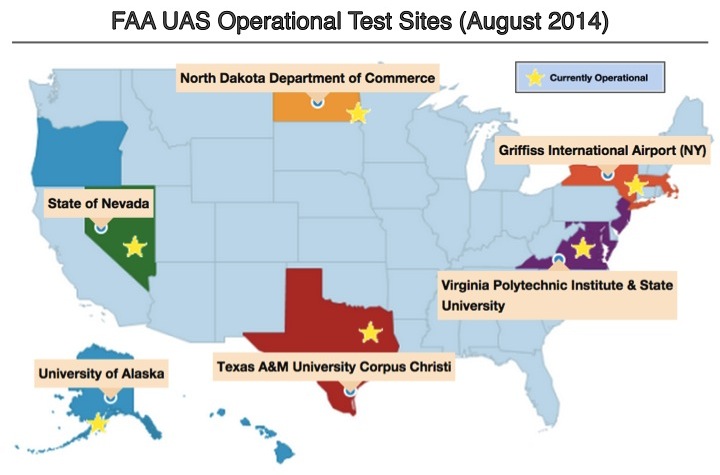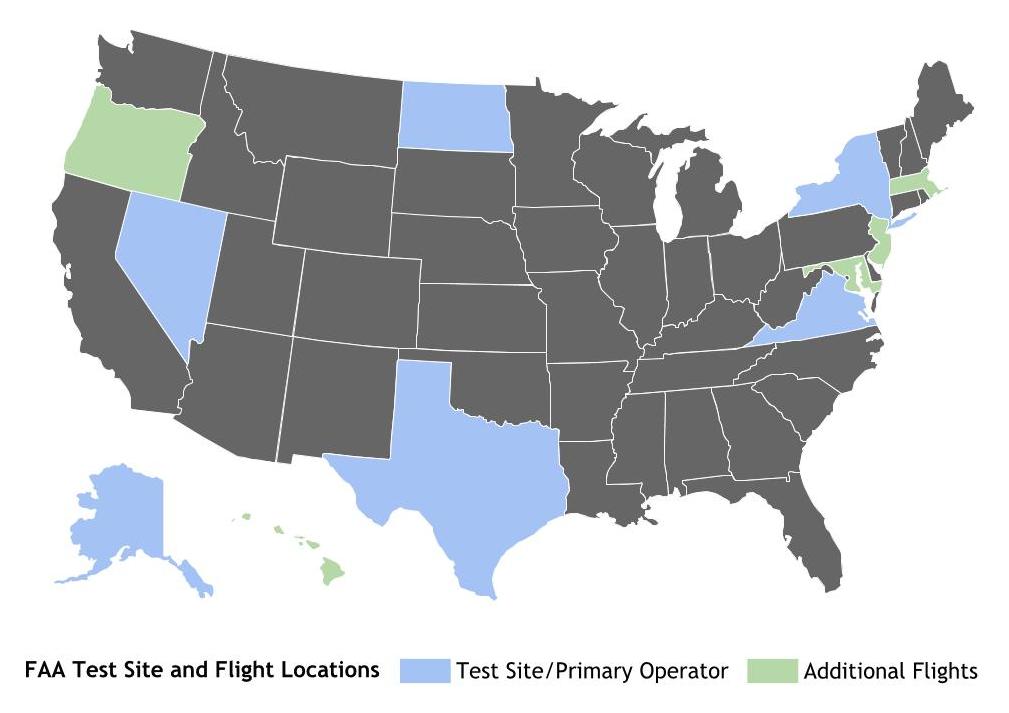
Image courtesy of Flickr user Don McCullough pursuant to a Creative Commons CC BY 2.0 license.
“Drone journalism” refers to the use of “unmanned aerial vehicles” (UAVs) or “unmanned aerial systems” (UAS) for journalistic purposes. The law in this area is far from settled, and the legal scholarship on this subject is still developing. This page includes background on the Federal Aviation Administration’s (FAA) regulation of drones, as well as case law, resources from the FAA, and other resources addressing the many legal issues associated with the use of drones for journalistic purposes.
For the latest updates on this fast moving topic, please visit our blog.
We will be updating this page regularly, so if you know of a resource that we’ve missed, please let us know at medialaw [at] unc.edu.
FAA Regulation and UAS/UAV Test Sites
Beginning in 2012, following the passage of the FAA Modernization and Reform Act, the agency undertook a major effort to prepare the national airspace for the arrival of unmanned aircraft. The FAA first authorized the use of UAS in 1990, but its first major regulatory efforts have taken place in the past few years, as interest in UAS has grown. The agency’s most recent step, the opening of six test site/pilot projects, is one of many steps in the plan to integrate UAS into the nation’s airspace. All of the steps were laid out in the FAA Modernization and Reform Act. The act mandated the FAA’s creation of the test site/pilot project program, as well as the publication of a five-year roadmap and a comprehensive plan.
The FAA has moved forward – albeit slowly – with its charge to explore the myriad issues surrounding civilian UAS use, such as operator certification and air traffic congestion, in collaboration with private and public groups. In December 2013, after a “rigorous 10-month selection process,” the agency announced its selection of six test site operators: The University of Alaska, the State of Nevada, Griffiss International Airport (in Rome, NY), the North Dakota Department of Commerce, Texas A&M University, and Virginia Polytechnic Institute and State University (Virginia Tech). All test sites are now open and operational.

Image courtesy of the FAA faa.gov/uas/legislative_programs/test_sites/
Test Site Operations
While the test sites are located in six states, test flights will actually occur in more states – at least 11 – according to FAA press releases and site operators’ websites. For example, the University of Alaska site will operate flights in Hawaii and Oregon as well as Alaska; the Griffiss International Airport site will operate flights in New York and Massachusetts; and the Virginia Tech site will operate flights in New Jersey and Maryland in addition to Virginia. Other flights will take place in Nevada, North Dakota, and Texas.

The FAA has issued several press releases with details of test site operations and research. The work at each of the test sites centers on what the FAA has identified as the most pressing needs to consider before UAS are fully integrated into the nation’s airspace. The agency’s primary research goals fall into six categories:
- System Safety & Data Gathering
- Aircraft Certification
- Command & Control Link Issues
- Control Station Layout & Certification
- Ground & Airborne Sense & Avoid
- Environmental Impacts
To that end, each test site has been tasked with specific research projects. Across many test sites there is a focus on the potential for drone use in agriculture, ecology, and conservation efforts. The University of Alaska site has a research plan addressing development of safety standards, state monitoring of UAS, and navigation. Because of the site’s close proximity to Fairbanks International Airport – the two are just five miles apart – it offers a prime opportunity for evaluating coordination with air traffic controllers. This site also will conduct aerial surveys of wildlife, with an eye to exploring how UAS might be used to locate and count animals, including “caribou, reindeer, musk ox and bear.” The Nevada site will research air traffic control needs and certification for UAS operators. The Griffiss International Airport site, located in the congested northeast airspace corridor, will consider the implications of UAS on air traffic. This site also will focus on drones equipped with visual and thermal sensors that can monitor and evaluate agriculture. The North Dakota site (the first to open) will research and develop data on UAS airworthiness. This site also will have an agricultural focus, studying UAS used to evaluate soil and crop quality. The Texas A&M site will research safety protocols and explore UAS use for ocean preservation and restoration. Finally, the Virginia Tech site (the last to open) will focus on “failure mode testing,” risk evaluation, and aeronautical surveys of agriculture. All sites will continue testing through February 2017.
Regulatory Approaches
The areas of FAA research at the test sites mirror several “philosophical approaches to regulation” identified by attorneys Nabiha Syed and Michael Berry in their June 2013 Communications Lawyer article, “Journo-drones: a Flight over the Legal Landscape.” Syed and Berry identified six categories of – or approaches to – regulation and suggested that the categories offer an initial framework for understanding the still-emerging regulation of UAS. The six approaches to regulation are: operators, flight, property, devices, behavior, and consent. These regulatory approaches cover a range of drone issues ripe for debate.
For example, an operator-based approach might ask who can fly UAS, or what certification or licenses are required. The FAA already has certification requirements for some UAS operators, but is expected to build on those certifications as it finalizes a plan to integrate UAS into the national airspace. A flight-approach to regulation could consider “when, where, and how drones can be flown,” and whether operators should be required to keep the UAS within their line of sight at all times. One example of the flight-based regulatory approach can be found in a recently-announced FAA exemption permitting six film production companies to fly UAS, but not at night. A property-based approach might consider areas over which drones may fly, how populated those areas are, and whether the property is private or public. Just last week, the FAA announced that operators of UAS or model aircraft could face jail time or a financial penalty for flying within three miles of major sports stadiums, including those used for Major League Baseball and the National Football League. The announcement, which is an reiteration of a previous policy, is an example of a property-based approach to regulation of UAS. Device-based regulation might focus on restricting the capabilities of UAS, including audio and video recording or night-vision capabilities, or maintenance and equipment requirements. Regulating behavior could address what behavior or individuals could be filmed, such as whether it would be permissible to film private or personal activities, celebrities, or other high-profile individuals whose lives often are disrupted by publicity. Finally, a consent-based approach to UAS regulation might consider whether and how UAS operators might be required to get consent or provide notice in advance of filming.

All images CC licensed. Credits: (1) U.S. Customs and Border Protection/Gerald Nino (2) Flickr user VilleHoo (3) U.S. Navy (4) Flickr user gott.maurer (5) Wikipedia user Frankhöffner
Resources
The following section catalogs the most useful resources we have been able to find on drones. These resources might be listed in more than one category.
Recent Case Law
Huerta v. Pirker, NTSB Docket No. CP-217 (March 6, 2014)
- Decision disallowing an FAA fine against an individual who had used a small drone for purposes of taking and selling photographs around UVA.
- FAA announced it will appeal
Rivera v. Foley et al., Case No. 2014-cv-00196 (D. Conn., Feb. 14, 2014)
- Recently filed case. Rivera alleges 1st and 4th Amendment violations when police prevented him from using a drone to document a fatal car accident.
- The Hartford Courant provides a good summary of the facts
Information from the U.S. Government
FAA Notice Clarifying Current Policy on Operation of Unmanned Aircraft in the National Airspace System, 14 CFR 91 (Feb. 6, 2007) (Docket No. FAA-2006-25714)
- FAA current policy on unmanned aircraft.
- This enforceability of this policy was one of the key distinctions in the Pirker case.
FAA Unmanned Aircraft Fact Sheet
U.S. Federal Aviation Administration (FAA) Modernization and Reauthorization Act, §§ 331-336, Pub. L. 112-95, 126 Stat. 11 (2012)
- Act requiring FAA to develop rules on regulation of unmanned aircraft by 2015
Hearing: The Future of Unmanned Aviation in the U.S. Economy: Safety and Privacy Considerations
- U.S. Senate Committee on Commerce, Science, & Technology, Jan 2014
Overview of Drones and Drone Journalism
Brendan Gogarty & Isbel Robinson, “Unmanned Vehicles: A (Rebooted) History, Background and Current State of the Art,” Journal of Law, Information and Science. (2011)
- Examines the history and current state of UAV technology.
New Perspectives from the Sky, “Unmanned Aerial Vehicles and Journalism,” Digital Journalism. (2014)
- Offers a history of UAVs, a canvass of cases that could be categorized as drone journalism, the themes that emerge from this case analysis, and an in-depth look at how this technology impacts on journalism and mass communication.
Astrid Gynnild, “The Robot Eye Witness,” Digital Journalism. (February 20, 2014)
- Study investigates how use of drones for journalistic purposes might extend and improve the use of eyewitness accounts, especially in areas or fields where human coverage would be impossible or too dangerous.
Michael Berry, “The Drones are Coming… and for Now We Should Get Out of Their Way,” The Pennsylvania Lawyer. (March/April, 2014)
- Considers the legal landscape for domestic use of drones, with discussion of the significant public interest they could serve for journalists.
ACLU, Status of Drone Legislation State by State
- ACLU updated list on the status of drone legislation in states across the country
Ethical Use
Lilly Chapa, “Drone Journalism Begins Slow Take Off: Ethical, Legal Issues Abound as Drones Contemplated for Newsgathering,” News Media & the Law. (Spring 2013)
- Brief overview of some legal concerns including privacy and the first amendment, as well as a brief discussion of ethical considerations
Kathleen Bartzen Culver, “From Battlefield to Newsroom: Ethical Implications of Drone Technology in Journalism,” Journal of Mass Media Ethics: Exploring Questions of Media Morality. (2014)
- Examines the early ethical considerations among drone journalism developers and digital information activists, and places them against the backdrop of utilitarian ethical theory applied to journalism. Suggests articulation of ethical guidelines and transparency with the public to address the adverse effects of use of this technology.
Privacy
John Villasenor, “Privacy, Security, and Human Dignity in the Digital Age: Observations from Above: Unmanned Aircraft Systems and Privacy,” Harvard Journal of Law & Public Policy. (Spring 2013)
- Suggests new frameworks for privacy laws in both federal and state legislation.
Ryan Gallager, “Privacy Risk or Future of Aviation? Five Perspectives on Domestic Drones,” Slate, 4/3/13
- Reports on FAA’s 4/3/13 “engagement session” on drone privacy.
Timothy T. Takahashi, “Drones and Privacy,” The Columbia Science & Technology Law Review. (March 23, 2013)
- Examines use of surplus drones and other quasi-military drone technology on the home front and possible standards for how the Fourth Amendment governs robotic surveillance.
Chris Schlag, “The New Privacy Battle: How the Expanding Use of Drones Continues to Erode our Concept of Privacy and Privacy Rights,” Pittsburgh Journal of Technology, Law & Policy. (Spring 2013)
- Discusses the development of drone technology, analyzes the integration of drones into domestic airspace, evaluates Fourth Amendment privacy issues, current regulatory schemes, administrative controls, and judicial protections, and considers potential solutions to privacy concerns.
Roger Clarke, “The Regulation of the Impact of Civilian Drones on Behavioural Privacy,” Forthcoming in Computer Law & Security Review. (June 2014)
- Questions whether existing regulatory frameworks can cope with changes in drone technologies and drone economics. Documents the nature and characteristics of different drones, the purposes to which they are put, and the impacts they could have. Concludes that careful consideration is needed of the adequacy of controls over the impacts of drones on public safety and behavioral privacy.
First Amendment
John Villasenor, “Privacy, Security, and Human Dignity in the Digital Age: Observations from Above: Unmanned Aircraft Systems and Privacy,” Harvard Journal of Law & Public Policy. (Spring 2013)
- Discusses how drones might affect questions of the first amendment including publication of private facts.
Amicus Brief from Coalition of News Organizations in Support of Raphael Pirker, May 2014
- Challenging FAA drone policies on First Amendment grounds
Matthew Schroyer, “Drone Lawyer: First Amendment Right to Photograph Extends to Drone Journalism,” Small Unmanned Aircraft System Industry News for Professionals. (February 20, 2014)
- Reviews the lawsuit by Connecticut-based photographer and drone journalist Pedro Rivera alleging violation of First Amendment right to monitor police using a drone.
Fourth Amendment
John Villasenor, “Privacy, Security, and Human Dignity in the Digital Age: Observations from Above: Unmanned Aircraft Systems and Privacy,” Harvard Journal of Law & Public Policy. (Spring 2013)
- While the Supreme Court has never ruled on drones, this article discusses potentially relevant precedent concerning fourth amendment cases.
Timothy T. Takahashi, “Drones and Privacy,” The Columbia Science & Technology Law Review. (March 23, 2013)
- Examines use of surplus drones and other quasi-military drone technology on the home front and possible standards for how the Fourth Amendment governs robotic surveillance.
Robert Molko, “The Drones are Coming! Will the Fourth Amendment Stop Their Threat to Our Privacy?” Brooklyn Law Review. (Summer, 2013)
- Examines the United States v. Jones decision, which reviewed the constitutionality of using GPS to monitor the location of cars in public, and its dicta indicating that Fourth Amendment limitations could apply in the future in the context of drone surveillance of neighborhoods.
Schools Studying Drone Journalism
Missouri Drone Journalism Program, Missouri School of Journalism
- Site has many articles about drone journalism and the program at Missouri.
University of Nebraska-Lincoln Drone Journalism Lab, College of Journalism and Mass Communications
- Site has many articles and videos on use of drones for journalistic purposes.
Terry Ganey, “Drone Journalism Hovers on Edge of News Gathering,” Gateway Journalism Review. (Spring 2013)
- Discusses programs at the University of Missouri and University of Nebraska on using unmanned aerial vehicles to collect video for use in multimedia news presentations.
Megan O’Neil, “Drone-Journalism Programs Seek Approval to Resume Flying,” Chronicle of Higher Education. (September 13, 2013)
- Reports on attempts by the Drone Journalism Lab at the University of Nebraska at Lincoln in Lincoln, Nebraska and the Missouri Drone Journalism Program at the University of Missouri in Columbia, Missouri to resume using unmanned aircraft in journalism education after receiving cease-and-desist letters from the FAA in July. Both were in the early stages of obtaining certificates of authorization from the FAA, which are required of public agencies (including public universities and police departments) that want to fly drones outdoors.
(These sources were primarily supplied by David Hansen, a reference librarian and clinical assistant professor at the UNC School of Law; Kate Dickson, a student at the UNC School of Information and Library Science; and Liz Woolery, a doctoral student at the UNC School of Media and Journalism.)
